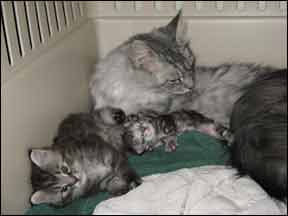Humane considerations overwhelmingly support the practice of spaying — the surgical removal of a female cat’s ovaries and uterus — when an animal is about six months of age. Perhaps the most compelling argument in favor of this procedure (also known as ovariohysterectomy) is the reduction of feline overpopulation. One study has found that 85 percent of cats that are dropped off at shelters are eventually destroyed. It is estimated that as many as three to four million unwanted cats and kittens are put to sleep annually in the U.S.

288
But cats that are loved and well-cared-for by their owners are also likely to benefit significantly from spaying during kittenhood. The procedure will, for example, preclude a young female’s development of mammary tissue and thus reduce by about 90 percent her chances of developing mammary cancer later in life. And because spaying entails removal of the uterus, the procedure virtually eliminates the possibility that a female cat will ever develop a condition called pyometra — a potentially fatal disorder in which a pus-filled uterus becomes grossly distended, and, if unrelieved, apt to burst.
Opportunistic Infection. Pyometra is the result of infection by opportunistic bacteria that migrate from the vagina to the uterus and colonize there. When an intact female cat reaches puberty, she will begin her estrous cycles, commonly known as periods of “heat.” An animal will typically go into heat for about a week and will then go out of heat for about two weeks. If she mates and ovulation occurs, a hormone called progesterone, which thickens the endometrium and prepares it for pregnancy, is secreted by the ovary.
Over time, the endometrial tissue of female cats that have repeatedly ovulated without becoming pregnant will increase in size and thickness due to the long-term effect of the progesterone; the pores in the tissue will become clogged and will form cysts; and the progesterone secretion, which suppresses the immune system during pregnancy, will make the uterus vulnerable to bacterial infection. This condition — called cystic endometrial hyperplasia (CEH) — sets the stage for pyometra.
Bacterial Invasion. With the animal’s natural defense mechanisms impaired, bacteria that naturally reside in the vaginal tract can migrate and proliferate within the uterus. These bacteria stay localized within the uterus, but they produce toxins that are released into an animal’s bloodstream and circulate throughout its body. The cat will develop antibodies to the toxins, and the effect can seriously interfere with kidney function and can progress to kidney failure.
More characteristically, however, the presence of uterine bacteria will prompt the release of white blood cells to the organ’s interior — and a consequent buildup of pus that can swell the uterus to the bursting point. If untreated, pyometra is likely to be fatal if the uterus ruptures and toxins are spilled into the abdomen.
Treatment Options. Physical examination, patient history and X-rays may be sufficient to achieve a definitive diagnosis of pyometra, although ultrasound imaging may sometimes be necessary. In some cases, the disorder may be treated medically — relying on hormone therapy aimed toward causing the uterus to contract and the cervix to open, which would allow the accumulated pus to drain via the vaginal canal. This treatment option, she points out, is used primarily in cases involving especially valuable cats whose owners are determined to preserve their animals’ breeding potential. But in 99 percent of cases, the condition will be treated surgically in an operation that is, in essence, a spay procedure.
However, that the surgical procedure is apt to be lengthy and very delicate. You have to keep in mind that the patient is toxic and very weak and could die from the anesthesia alone. The veterinarian has to be careful that this pus-filled organ doesn’t explode while he or she is working to detach it. Also of concern is the fact that the swollen uterus is putting pressure on the patient’s entire circulatory system, and the abrupt removal of the organ can cause a dramatic drop in blood pressure.
Prevention. Experts strongly urges owners to have their female cats spayed at the age of six months or so. Prices for routine spays vary among veterinary practices from less than 100 dollars to over 300 dollars. But if you don’t have the procedure done — and the cat eventually develops pyometra — the surgery will cost a great deal more and risk the life of your cat.
Will removing a young female cat’s ovaries and uterus guarantee that she will never experience pyometra? Yes, with one possible exception. In a spay surgery, a small portion of the uterus — called the uterine stump — is left attached to the cervix. The veterinary surgeon has to do this in order to enable proper suturing and to prevent bleeding and leakage.
If a portion of the ovary is accidentally left behind or if the cat is treated with a drug that acts like an ovarian hormone, it is theoretically possible for this tiny uterine stump to develop into a pyometra. But don’t let such a rare chance keep you from spaying your cat and giving her overwhelmingly favorable odds of avoiding a truly dangerous and preventable condition.


